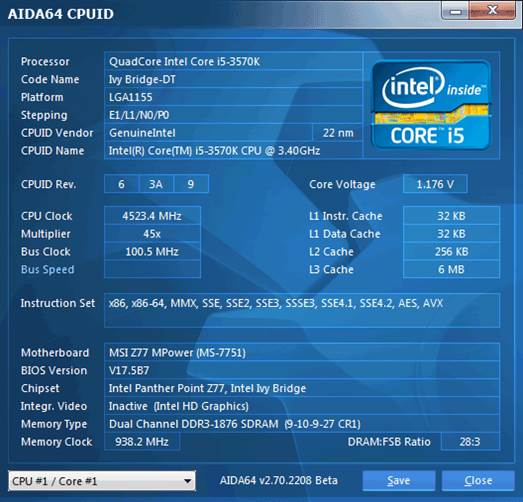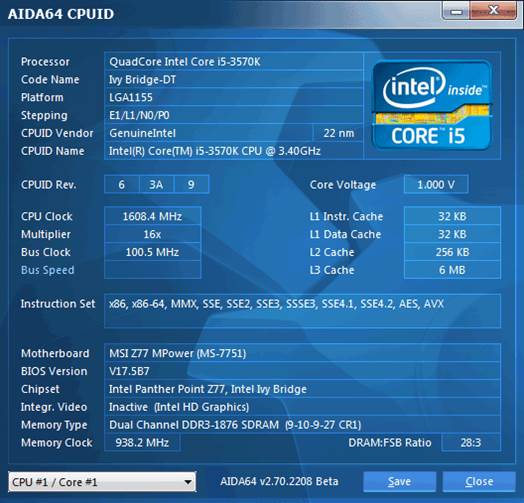After booting, MSI Z77 MPOWER mainboard
displayed a start-up image, where they informed us of hot keys.

Start-up
image
Moreover, even if you disable start-up
screen in profile or by pressing Tab key, there will be still hot-key icons in
the screen’s bottom. But, for some reasons, the mainboard didn’t display current
processor frequency. We only saw the nominal frequency, which was not real. We
also saw memory size of operating frequency on screen.

The
mainboard didn’t display current processor frequency
In our MSI Z77-GD65 mainboard review, we were
pleased seeing a new parameter called “Enhanced Turbo” in BIOS. This parameter enables
this specific processor‘s clock frequency multiplier to rise to the maximum
under any type of load, as allowed by Intel Turbo Boost. But, our thought about
this function has changed and we have intention of considering implementing it on
MSI Z77 MPOWER mainboard as a downside rather than an upside. The first reason is
for “Enhanced Turbo” section activated by default, thus the processor didn’t
work in its nominal mode. This function can be easily disabled, but even after the
nominal mode couldn’t be restored. The processor clock frequency multiplier of
our test Core i5-3570X processor will only increase up to 36x, though under low
load, it could rise up to 38x. the problem is “Intel C-State” parameter was set
at “Auto” in BIOS, but in this case, it wasn’t effective, and you have to
change the profile manually to “Enable”. Because all of APS (Active Phase
Switching) energy-efficient technologies didn’t work at default, Micro-Star has
the right to view this technology as one of the mainboard’s advantages, and
what would happen once this advantage disappears? It must be a mistake not to
think that won’t happen in this case and the mainboard simply loses an upside. When
upside isn’t available, downside is still and we are inclined to prove it via
the following power efficiency test, in this review.
Another feature of Micro-Star mainboards is
their automatic overclocking system dubbed “OC Genie II”, which allows
overclocking the system by choosing the relative option in the BIOS or pressing
the button having familiar names. We have no intention of overestimating its
potential, as like any other automatic overclocking system it has
imperfections, but several undeniable good points. The problem is that many
similar technologies of other manufacturers only overclock the processor, and completely
leave the memory. In our tests, we increased the processor frequency to 4.2GHz,
but “OC Genie II” technology also increased the memory frequency to 1867 MHz
and assigned all appropriate timings for it, with the help of the X.M.P.
profile recorded in SPD module. This is a right approach, since system should
be internally overclocked.

Increase
processor frequency up to 4.2GHz
Everybody knows that no automatic
overclocking system will create the same exceptional and equivalent results as
manual overclocking, when each parameter is carefully selected. However,
overclocking with Micro-Star mainboards may not be flexible. The problem is that
their voltage regulator circuitry doesn’t allow increasing the processor core
voltage in Offset mode by increasing value to the nominal setting, and if the V-core
is configured at a fixed value, then all power-efficient technologies will malfunction.
We explained many times in our reviews why power-saving modes were essential
even for overclocked systems, and the most recent occasion when we focused on
this topic in detail was in Gigabyte GA-Z77X-UP7 mainboard review, hence,
we won’t repeat all of them here . However, processors, which are overclocked
by raising clock frequency multiplier, will be pushed to the limit with all of Intel’s
power-saving technologies and MSI’s proprietary APS technology unscratched even
on MSI mainboards. All necessary is to overclock without raising the core
voltage. So, it is impractical to overclock our specific test processor to the maximum
of 4.6 GHz. In our case, even 4.5GHz became a challenge and only given in when
we set the V-droop at the maximum. Concurrently, we set the memory frequency to
1867 MHz and adjusted its timings relatively.

4.5GHz
became a challenge
The system was overclocked in a way that it
could be used in this mode for a long time. We did not inactivate any feature
of the mainboards or onboard controllers, yet kept all power-saving
technologies still and operating normally, thus in idle mode the CPU voltage
and frequency multiplier will become lowered, and all idling processor units will
be disabled to bring the CPU into the energy-efficient mode. The proprietary
APS power-saving technology of MSI was also raised and ran plus adjusted with the
number of active phases in the processor voltage regulator circuit according to
the level of loads.

No
function was disabled.
Comparing performance
As usual, we tend to compare the
mainboard’s speed in two different modes: nominal and overclock CPU plus
memory. The first mode was interesting as it showed how well the mainboard
worked with default settings. A truth known is most users don’t adjust their
system much; they simply choose the optimized BIOS setting and do nothing else.
That is the reason why we had a test around without interfering the mainboard’s
default setting by any mean. To make comparisons, we include test results of
previous mainboards:
·
ASRock Fatal1ty Z77 Professional
·
ASRock Z77 Extreme4 and ASRock Z77 Extreme6
·
ASRock Z77 Extreme9
·
ASRock Z77 OC Formula
·
Asus Maximus V Formula
·
Asus P8Z77-V Deluxe
·
Asus P8Z77-V LX
·
Asus P8Z77-V Premium
·
Asus Sabertooth Z77
·
Gigabyte G1.Sniper 3
·
Gigabyte GA-Z77X-UD3H and GA-Z77X-UD5H-WB WIFI
·
Gigabyte GA-Z77X-UP4 TH and Gigabyte GA-Z77X-UP5
TH
·
Gigabyte GA-Z77X-UP7
·
Intel DZ77BH-55K
·
Intel DZ77GA-70K and Intel DZ77RE-75K
·
MSI Z77A-GD65
The results on the
list were decently arranged.